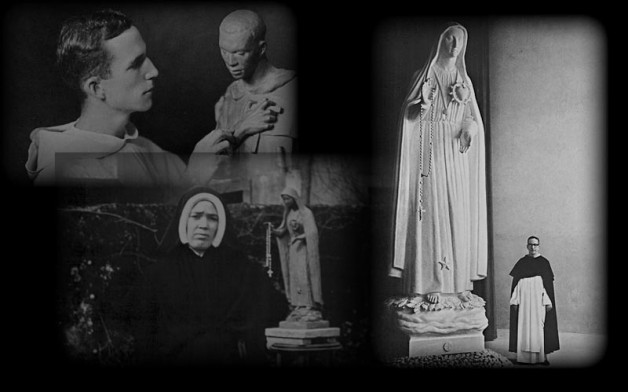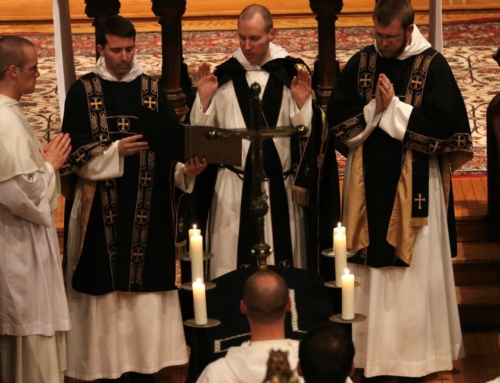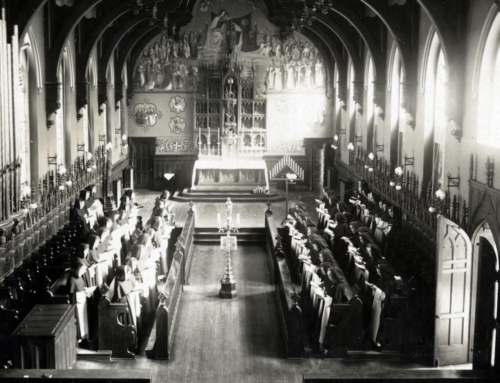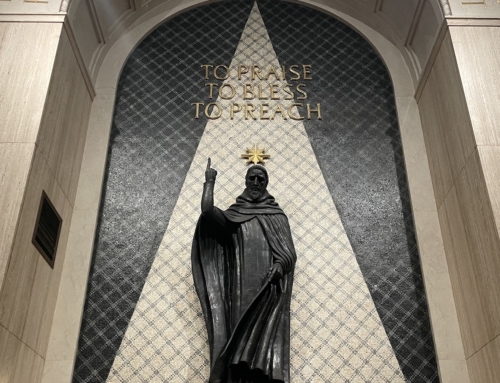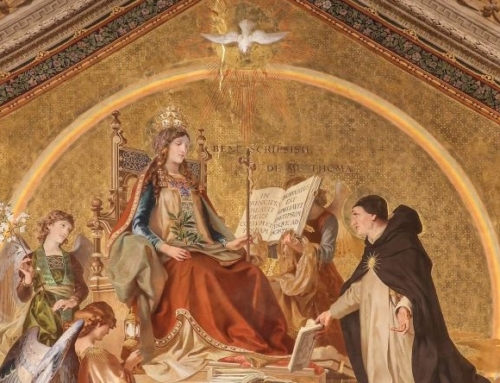This year marks the ninety-fifth anniversary of the apparitions of the Blessed Mother to three children at Fatima, Portugal. On September 13, 1917, Our Lady appeared for the fifth time at the Cova da Iria (“Irene’s Cove”), where these three children tended sheep. It is a little known fact that a Dominican friar of our Province of St. Joseph enjoyed a unique encounter with one of these child visionaries. The visionary’s name was Sr. Lucia, and the priest was Fr. Thomas McGlynn, O.P. Before recounting how this encounter took place, a little background must be given.
Fr. McGlynn was a Dominican priest with a gift for sculpture that manifested itself in early childhood and lasted throughout his entire life. Many of his works can be found throughout our province, the country, and even in the Vatican. His legacy is especially remembered in a studio dedicated to his life and work at our own Providence College in Rhode Island. Though he produced many masterpieces, none of his works has a more remarkable history than the statue he crafted under the personal direction of Sr. Lucia herself: the first accurate representation of Our Lady of Fatima.
In the fall of 1946, Fr. McGlynn, fourteen years ordained and forty years of age, found himself teaching oratory at Providence College. During this time, according to his biographer and understudy, Fr. Ambrose McAlister, O.P., Fr. McGlynn continued to apply himself to sculpture. With the permission of his superiors, he rented an old barn in the Olneyville section of Providence to serve as a studio.
The original inspiration to sculpt an image of Our Lady of Fatima actually came from a commission. The story goes that six years earlier, at the first meeting of the Liturgical Society of the United States, McGlynn had come into contact with the Rigali Brothers from Daprato Studios in Chicago. The Rigalis, who were in the business of making plaster replications of original works, approached Fr. McGlynn to commission sculptures that could be copied and then sold with significant savings to churches. McGlynn could not accept their offer at the time; but now, six years later, living at Providence College with his own studio, he was in a different position. He approached the brothers about their earlier proposal, and a formal contract was signed. For the first time, McGlynn was in business as a professional sculptor.
It was agreed that he would produce three pieces for the Rigalis: one of the Blessed Virgin, one of the Sacred Heart, and one of St. Joseph. At the suggestion of two of his classmates, Fr. McGlynn decided that his Marian statue would be a representation of Our Lady of Fatima. He completed his first version of the statue, which the Rigalis approved, but then he began to express concern to his friends that it would not be accepted as an authentic representation of the children’s visions. Fatefully, a woman asked him, “Why don’t you go to Portugal to see Sister Lucy?“
With that idea planted in his mind, Fr. McGlynn called the Rigalis, who gave their approval and even offered to pay for the trip. Having received the permission of his superiors, McGlynn flew to Lisbon in February of 1947 with a letter of introduction from Cardinal Spellman to Cardinal Cerejeira, Bishop of Lisbon.
Cardinal Cerejeira welcomed McGlynn and in turn wrote him a letter of introduction to Bishop Don Jose de Silva, the ordinary of Leira-Fatima. It fell to Bishop de Silva to determine who would have permission to visit Sr. Lucia, who was living 200 miles north of Fatima in a convent at Vila Nova de Gaia. It was a permission rarely given, but Fr. McGlynn was granted his request, and, with the Irish Dominican Fr. Gerard Gardiner acting as interpreter, he finally met Sr. Lucia.
After careful examination of the statue, which McGlynn had brought with him, Sr. Lucia pronounced her verdict: the statue was inaccurate. Up to this point, McGlynn had thought only minor alterations would be necessary, but, confronted with the judgment of Sr. Lucia, he now faced a decision difficult for any artist: stay true to his own artistic intuition or start from scratch and take direction from another. To his credit and with another permission, he remained at the convent to produce an entirely new statue under the direction of Sr. Lucia. The result became the archetype for all subsequent representations of the image of Our Lady of Fatima. A few five foot copies of this original were made by Fr. McGylnn of which one now resides at the Church of St. Vincent Ferrer in New York City. The original would also serve as the model for the 20 foot statue Fr. McGlynn carved especially for the Basilica tower at Fatima.
The remarkable thing about Fr. McGlynn’s encounter with Sr. Lucia is that every step of his journey was taken under religious obedience. When entering religious life we bring our talents and gifts with us, but we have to be ready to put them aside or use them only as God sees fit. Yet, when we entrust our lives to those whom God has placed in charge of us, our gifts and talents often have a greater impact than we could ever have imagined possible. This was certainly the case with Fr. McGlynn’s sculpture. What began with a superior’s permission became a work of art glorifying God and giving honor to his blessed mother.
✠
Images clockwise from top left: Fr. McGlynn working on a sculpture of St. Martin De Porres, Fr. McGlynn standing next to the completed marble carving of Our Lady of Faitma that now resides in the Basillica tower at Fatima, and finally Fatima visionary Sr. Lucia in Portugal (1947) standing next to the completed image of Our Lady of Fatima that was crafted under her direction by Fr. McGlynn. All images and sources in the text above are from Thomas McGlynn: Priest and Sculptor, written by Fr. Ambrose McAlister, O.P. and published by Providence College Press in 1981.

